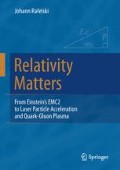Abstract
Time dilation and Lorentz-FitzGerald body contraction are two properties of a body required to assure unobservability of the absolute body speed \(v\). We meet the question: is relativistic body contraction as real as time dilation? We discuss the confusion surrounding this question. The path to relativistic coordinate transformation in 3+1 dimension is described. Recapitulation of the historical path to special relativity caps this chapter.
Access this chapter
Tax calculation will be finalised at checkout
Purchases are for personal use only
Notes
- 1.
Sir Joseph Larmor (1857–1942), Irish theoretical physicist, author of Æther and Matter, credited with discovery of the Lorentz coordinate transformation, see Ref. 34.
- 2.
M.N. Macrossan, “A note on relativity before Einstein,” The British Journal for the Philosophy of Science 37, 232 (1986) says: “…the credit for the first presentation of the Lorentz coordinate transformation, including the crucial time dilation, belongs to…” J. Larmor, “On a dynamical theory of the electric and luminiferous medium,” Phil. Trans. Roy. Soc. 190, 205 (1897); J. Larmor, Aether and Matter, Cambridge University Press (1900).
- 3.
George Francis FitzGerald (1851–1901), Irish physicist, worked at Trinity College, Dublin; see G.F. FitzGerald, “The ether and the earth’s atmosphere”, Science 13, 390 (1989).
- 4.
(See box); H.A. Lorentz, “The relative motion of the earth and the æther,” Versl. Kon. Akad. Wetensch. 1, 74 (1892).
- 5.
A. Einstein, “Zum Ehrenfestschen Paradoxon. Eine Bemerkung zu V. Variĉaks Aufsatz”. Physikalische Zeitschrift 12, 509–510 (1911); Original: “Der Verfasser hat mit Unrecht einen Unterschied der Lorentzschen Auffassung von der meinigen mit Bezug auf die physikalischen Tatsachen statuiert. Die Frage, ob die Lorentz-Verkürzung wirklich besteht oder nicht, ist irreführend. Sie besteht nämlich nicht “wirklich”, insofern sie für einen mitbewegten Beobachter nicht existiert; sie besteht aber “wirklich”, d. h. in solcher Weise, daß sie prinzipiell durch physikalische Mittel nachgewiesen werden könnte, für einen nicht mitbewegten Beobachter.” The author of this book translated this paragraph, taking into account the shift in usage of the scientific language in the past 100 years.
- 6.
Hendrik A. Lorentz, Proceedings of the Royal Netherlands Academy of Arts and Sciences 6, 809–831 (1904) available at Wiki-sources: http://en.wikisource.org/wiki/Electromagnetic_phenomena.
- 7.
Henri Poincaré, “Sur la dynamique de l’électron,” (On the Dynamics of the Electron), Comptes rendus de l’Académie des Sciences 140, 1504–1508 (1905), footnoted as presented at an Academy session on June 5, 1905.
- 8.
Henri Poincaré, “Sur la dynamique de l’élctron,” Rendiconti del Circolo Matematico di Palermo 21, 129–176, doi:10.1007/BF03013466.
- 9.
Max Planck (1858–1947), a renowned German theoretical physicist is said to have made two breakthrough discoveries: that of Planck constant, i.e. quantum of action \(\hbar\), and of Albert Einstein.
Author information
Authors and Affiliations
Rights and permissions
Copyright information
© 2017 Springer International Publishing AG
About this chapter
Cite this chapter
Rafelski, J. (2017). Material Bodies in Special Relativity. In: Relativity Matters. Springer, Cham. https://doi.org/10.1007/978-3-319-51231-0_3
Download citation
DOI: https://doi.org/10.1007/978-3-319-51231-0_3
Published:
Publisher Name: Springer, Cham
Print ISBN: 978-3-319-51230-3
Online ISBN: 978-3-319-51231-0
eBook Packages: Physics and AstronomyPhysics and Astronomy (R0)

